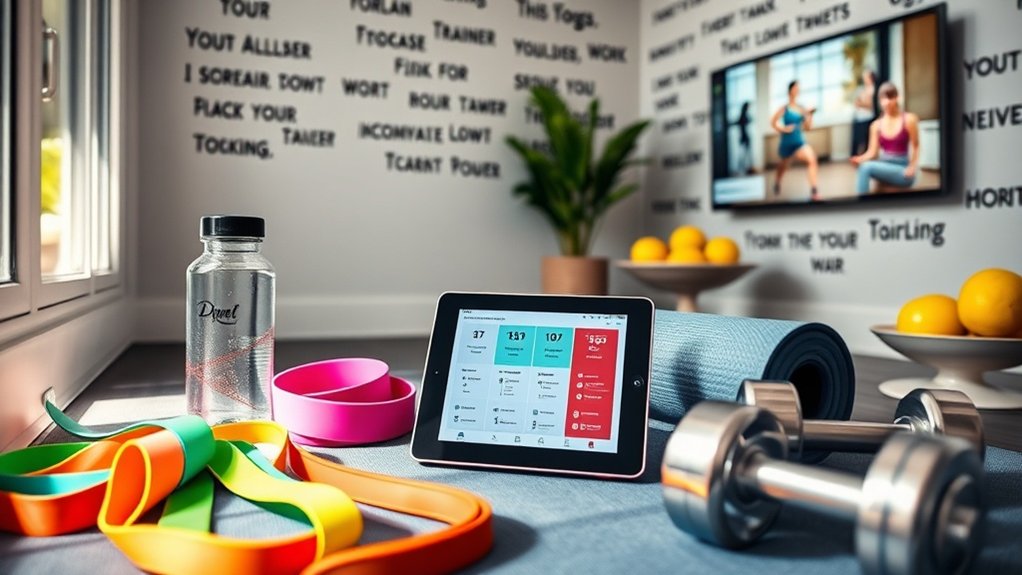Start by evaluating your baseline fitness through standardized tests, then set SMART goals targeting 0.5-1% weekly body weight changes. Choose a training split (full-body, upper/lower, or push/pull/legs) matching your schedule and experience level. Select compound movements prioritizing available equipment, then implement progressive overload with 2-5% weekly increases across 4-12 week mesocycles. Structure your sets, reps, and rest periods according to hypertrophy or strength adaptations. Integrate 2-3 recovery days, prioritize 7-9 hours of sleep, and track metrics using digital systems. The following thorough framework reveals precisely how you’ll manipulate these variables for sustainable results.
Assess Your Current Fitness Level and Establish SMART Goals

Before designing an effective workout plan, you must establish a quantifiable baseline of your current fitness level through standardized assessments. Evaluate cardiovascular endurance by timing a mile walk/run, test muscular strength through one-minute push-up and squat counts, and measure body composition and flexibility. Document these results to track progress throughout your fitness journey.
Next, establish SMART goals that provide structure and clarity. For weight loss, set a realistic target of 0.5-1% body weight reduction weekly; for muscle gain, aim for 0.25-0.5% increases. Confirm your objectives are Specific, Measurable, Achievable, Relevant, and Time-bound.
Critically, align these goals with your personal interests and long-term aspirations. This alignment boosts commitment and greatly improves your likelihood of sustained success in achieving desired outcomes.
Choose Your Optimal Training Split and Weekly Schedule
After establishing your baseline metrics and SMART goals, you’ll select a training split that maximizes your physiological adaptations while fitting your schedule constraints.
Your customized workout plan should incorporate structured workout plans, which demonstrate 23% superior strength gains and 18% improved endurance increasements versus unstructured approaches. Choose between Full-Body, Upper/Lower Body, or Push/Pull/Legs configurations based on your experience level and fitness goals.
Implement a 3-5 day weekly schedule that optimizes muscle growth while preventing overtraining. Strategic active rest days featuring light activities promote recovery without compromising momentum.
Your training split must align with personal commitments to boost adherence—the primary determinant of long-term success. This evidence-based framework guarantees your weekly schedule delivers measurable progress toward your established objectives while accommodating real-world constraints.
Select Exercises Based on Equipment, Experience, and Individual Limitations

Your exercise selection must align with three critical factors: the equipment you can access, your current training experience, and any physical limitations that affect movement quality or safety.
Research demonstrates that effective program design requires matching exercise complexity to skill level—beginners benefit from mastering fundamental movement patterns before progressing to advanced variations.
You’ll need to systematically evaluate each exercise choice against these constraints to build a sustainable routine that maximizes results while minimizing injury risk.
Equipment Availability and Alternatives
How can you maximize training effectiveness when equipment availability varies greatly? Your personalized workout requires strategic exercise selection based on accessible resources. When equipment availability is limited, bodyweight exercises like push-ups, squats, and lunges deliver substantial strength training benefits by engaging multiple muscle groups simultaneously.
| Equipment Type | Primary Exercises | Muscle Engagement |
|---|---|---|
| Bodyweight | Push-ups, Squats, Lunges | Full-body integration |
| Resistance Bands | Rows, Presses, Extensions | 60-80% muscle activation |
| Kettlebells/Free Weights | Deadlifts, Overhead Press | 70%+ fiber recruitment |
Prioritize compound movements that use multiple joints, as they recruit up to 70% more muscle fibers than isolation exercises. Incorporate resistance bands or kettlebells to improve workout diversity while maintaining safety throughout your fitness journey. Align exercise selection with your experience level and physical limitations to guarantee consistent progress.
Experience Level Considerations
Because exercise selection directly impacts injury risk and training outcomes, matching movements to your current capabilities establishes the foundation for sustainable progress. Your personalized workout must reflect your experience level and current fitness abilities.
Beginners should prioritize fundamental movement patterns—squats, push-ups, and hinges—to develop neuromuscular coordination before advancing. This approach builds technical proficiency while minimizing injury risk in your training plan.
Advanced individuals can implement structured split routines (upper/lower or push/pull/legs) that accommodate higher training volumes and exercise complexity.
Regardless of experience level, your fitness progression depends on progressive overload—systematically increasing training demands through volume, intensity, or complexity. Regularly reassess your workout performance and adjust exercise selection accordingly.
This evidence-based strategy guarantees your personalized workout evolves with your capabilities, optimizing adaptation while maintaining appropriate challenge levels for sustained advancement.
Working Around Physical Limitations
While progressive overload drives adaptation, physical limitations require strategic exercise modifications to maintain training consistency without undermining safety.
Your personalized workout must account for injuries and mobility restrictions that could jeopardize training effectiveness. Assess available equipment and your current fitness experience level to identify suitable alternatives that deliver stimulus without exacerbating existing conditions.
Implement these modifications for a safe workout routine:
- Use bodyweight exercises for joint-friendly resistance that accommodates various physical limitations.
- Incorporate resistance bands to provide variable tension while reducing stress on compromised areas.
- Select bilateral or unilateral movements based on asymmetrical limitations to maintain balanced development.
Progressive overload remains achievable through controlled progressions—adjusting range of motion, tempo, or volume rather than exclusively increasing load.
This approach guarantees your effective workout continues driving adaptation while respecting physiological constraints.
Implement Progressive Overload and Periodization Strategies

To maximize your training adaptations, you’ll need to systematically apply progressive overload principles by increasing training stress through load, volume, or intensity modifications of 2-5% weekly.
Your program must incorporate periodization cycles that alternate between accumulation and intensification phases, typically structured in 4-12 week mesocycles to optimize neuromuscular adaptations while mitigating overtraining risk.
You’ll achieve consistent 5-10% monthly strength gains by implementing weekly tracking protocols that quantify performance metrics and inform necessary programming adjustments.
Understanding Progressive Overload Principles
Progressive overload serves as the fundamental mechanism driving continuous adaptation in strength training, requiring systematic increases of 2-5% in training variables—weight, repetitions, or intensity—to force muscular and neurological advancement.
You’ll achieve 5-10% strength gains monthly by consistently applying this principle alongside periodization strategies that cycle training intensity and volume. Your workout plans must incorporate structured recovery phases to prevent plateaus and optimize muscle growth across all fitness levels.
Key implementation strategies include:
- Track performance metrics weekly to quantify strength gains and determine when adjustments are necessary
- Increase training load incrementally rather than drastically to guarantee sustainable progression
- Align intensity modifications with your current recovery capacity and adaptation rate
This evidence-based approach guarantees continuous physiological adaptation while minimizing overtraining risk, allowing you to achieve measurable results through calculated progressions.
Periodization Cycles and Phases
Because your body adapts to training stimuli within 4-6 weeks, periodization divides your annual program into distinct macrocycles (6-12 months), mesocycles (3-6 weeks), and microcycles (1 week) that strategically manipulate volume, intensity, and exercise selection.
Each phase targets specific adaptations: hypertrophy phases emphasize moderate weights with higher volume, strength phases prioritize heavy loads with lower reps, and endurance phases use sustained efforts.
You’ll apply progressive overload by increasing training variables 2-5% per microcycle. Research demonstrates that structured periodization yields 23% superior strength gains and 18% improved endurance increasements compared to linear programs.
Your workout plans require continuous assessment throughout training phases, allowing tailored training adjustments based on recovery capacity and performance metrics.
This systematic approach optimizes adaptation while reducing injury risk by preventing accumulated fatigue.
Tracking Strength Progression Weekly
When you systematically document each training session’s load, volume, and performance metrics, you establish quantifiable baselines that enable precise application of progressive overload principles.
To create a personalized workout plan with effective tracking, you’ll need structured methods to assess weekly performance and review and adjust based on concrete data.
Implement these tracking protocols for ideal strength progression:
- Digital logging systems: Record weights, repetitions, and rest intervals to identify 2-5% weekly increments
- SMART goals framework: Establish specific monthly targets (5-10% strength gains) with measurable checkpoints
- Performance analysis: Compare weekly data against periodization phases to determine when intensity modifications are necessary
This evidence-based approach guarantees your workout plan remains responsive to physiological adaptations, preventing stagnation while maximizing strength development through calculated progression strategies.
Determine Sets, Reps, Rest Periods, and Workout Duration

Structuring your training variables—sets, reps, rest periods, and session duration—directly influences whether you’ll achieve hypertrophy, strength, or endurance adaptations.
For muscle building, target 3-5 sets of 8-12 reps per exercise to maximize strength gains. Beginners should start with 2-5 sets of 8-15 reps, progressively increasing intensity as adaptation occurs.
Rest periods greatly impact your personalized workout outcomes. Implement 30-90 seconds between sets for hypertrophy-focused training, while strength-oriented sessions require 2-5 minutes for adequate recovery.
Your workout duration should remain within 30-60 minutes, maintaining a frequency of 2-4 sessions weekly for effective training.
Monitor fatigue levels consistently and adjust volume accordingly. Recovery isn’t optional—it’s essential for continued progress.
Your body’s adaptation depends on balancing training stress with adequate rest periods between sessions.
Integrate Recovery Protocols, Nutrition, and Deload Weeks
While training stimulus initiates adaptation, recovery protocols determine whether your body actualizes those gains or succumbs to overtraining. Schedule 2-3 rest days weekly for intense training programs, incorporating active recovery like walking or yoga to improve circulation.
Implement deload weeks every 4-8 weeks, reducing intensity and volume by 50% to minimize injury risk and facilitate mental restoration.
Your balanced diet must prioritize muscle repair through adequate proteins, carbohydrates, and fats. Target 7-9 hours of quality sleep nightly—it’s non-negotiable for hormonal balance and performance improvement.
Essential recovery framework:
- Progress tracking: Monitor performance metrics and body measurements to evaluate recovery effectiveness
- Nutrition timing: Align macronutrient intake with training demands
- Sleep hygiene: Establish consistent sleep schedules for ideal adaptation
Systematically adjust your protocols based on documented progress, assuring sustainable advancement toward your fitness objectives.
Track Progress Using Technology and Adjust Your Plan for Continuous Results

Technology transforms subjective fitness impressions into quantifiable data that drives systematic improvement. You’ll use fitness tracking apps and wearable devices to monitor workout frequency, intensity, and body composition changes, enabling evidence-based adjustments to your personalized workout plan. Data analysis reveals performance metrics trends, guiding you to modify training parameters for continuous results.
| Metric | Target Benchmark |
|---|---|
| Strength Gains | 5-10% monthly increase |
| Workout Frequency | Consistent weekly adherence |
| Performance Trends | Progressive overload maintenance |
| Body Composition | Measurable quarterly changes |
Review your workout journal or app logs regularly to track progress and identify plateaus. This systematic approach guarantees your fitness routine evolves with your objectives. Technology provides real-time feedback, allowing you to adjust volume and intensity while maintaining alignment with your fitness tracking apps’ insights for ideal adaptation.
Frequently Asked Questions
How to Create a Personalized Fitness Plan?
You’ll create your personalized fitness plan through thorough fitness assessment, strategic goal setting, selecting equipment based on workout preferences, scheduling workouts consistently, integrating nutrition considerations, implementing recovery techniques, and tracking progress systematically.
What Is the Trend in Exercise in 2025?
In 2025, you’ll find virtual fitness, wearable technology, and online coaching dominating trends. HIIT workouts, functional movement, and bodyweight exercises remain popular, while mindfulness training, nutrition integration, eco-friendly gyms, and group workouts improve your holistic wellness experience.
What Is the 3-3-3 Rule for Workout?
Think of the 3-3-3 rule as your fitness compass: you’ll perform three sets of three exercises targeting different muscles. This training principle maximizes workout efficiency while balancing strength training, cardio balance, and muscle recovery to achieve your fitness goals.
Can Chatgpt Design a Workout Plan?
Yes, ChatGPT designs workout plans by analyzing your fitness goals, workout preferences, and equipment choices. It recommends exercise types, duration factors, progress tracking methods, injury prevention strategies, recovery methods, nutrition alignment, and motivation strategies for ideal results.



